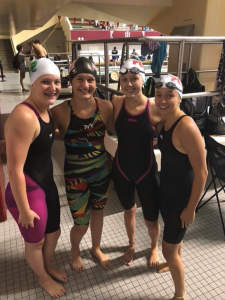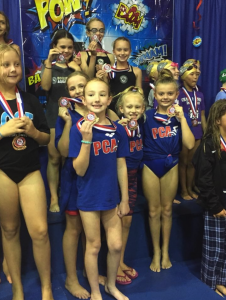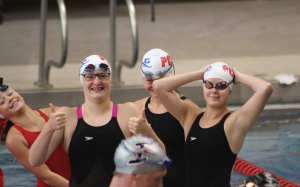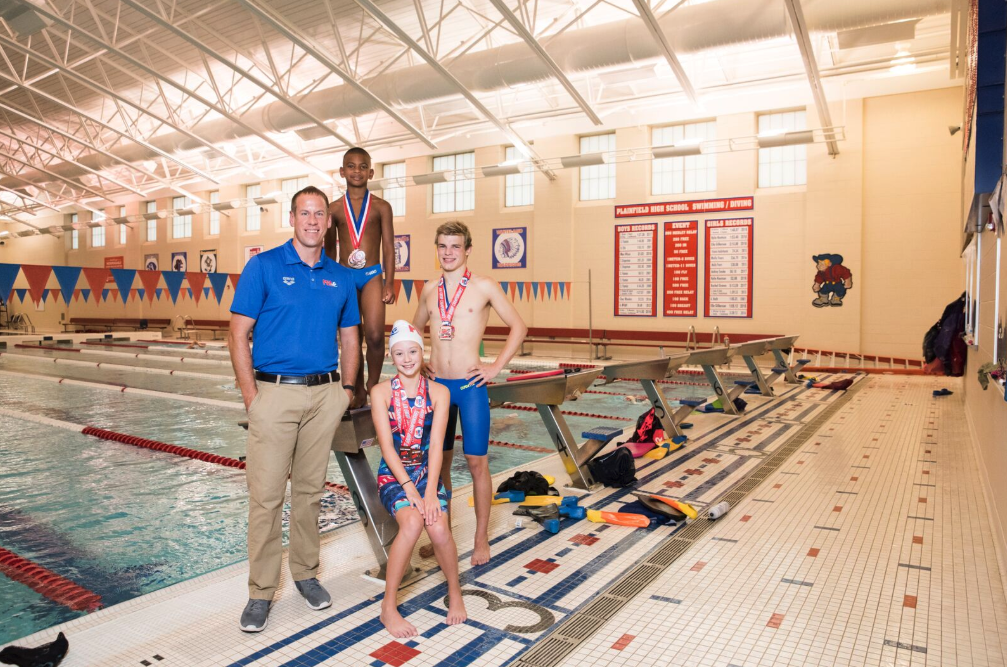Plainfield Community Aquatics Bolsters Students’ Skills, Confidence & Friendships
Photographer: Amy Payne
 At some point in all our lives, we learn that there are not enough hours in a day to squeeze in everything we want to do. Scott Johnson learned this truth at age 11 when his parents made him choose between his two big loves: baseball and swimming. Swimming won, and from then all the way through his college years, Johnson became a dedicated, year-round swimmer, taking part in both school teams and swim clubs.
At some point in all our lives, we learn that there are not enough hours in a day to squeeze in everything we want to do. Scott Johnson learned this truth at age 11 when his parents made him choose between his two big loves: baseball and swimming. Swimming won, and from then all the way through his college years, Johnson became a dedicated, year-round swimmer, taking part in both school teams and swim clubs.
When Johnson’s collegiate career ended in 2002, he started coaching as an assistant at Plainfield High School (PHS), his alma mater. In 2016, when PHS’s head coach retired after 26 years, Johnson applied for the job. Historically, PHS swim programs had been highly decorated and accomplished, but in recent years there had been a decline in performance. Therefore, during his interview, committee members asked Johnson if he had suggestions for how to bolster the school’s competitiveness in Plainfield. He absolutely did.
“I’d wanted to launch a year-round swim program for a while, and this was the perfect time to do it,” says Johnson, who became PHS’s head swimming & diving coach as well as the executive director and head senior coach of the nonprofit swim club called Plainfield Community Aquatics (PCA).
“With the athletic director’s support, I got the year-round program up and running,” says Johnson, noting that PCA is open to swimmers from anywhere and everywhere (not just Plainfield), ranging in age from 7 through college. They run practices for several ability groups. The entry-level group of the swim club practices four times a week for 90 minutes. As they progress to the higher-ability groups, high school students are in the water six days a week, twice a day. They currently have four full-time USA swim coaches — Johnson and three others.
“There’s a pretty stringent USA swimming protocol on getting certified to coach for the USA,” Johnson says. “It involves background checks, safety classes and athlete protection training.”
On the developmental side, they have 8-12 high school students and 3-4 adult coaches that run those programs. Parents pay a monthly fee based on the training group their child is involved in (how many hours are spent in the pool). The PCA also offers swim lessons to kids as young as age 4, getting them acquainted with water. As they develop skills in the strokes, the club provides more expansive programs.
Unlike a high school swim season that lasts for a handful of months, PCA practices run all calendar year with the exception of a two-week break in August and another two-week break in late March/early April.
 The other major difference between school teams and club swimming is that club swimming competition is much more expansive. They tend to last all weekend long and students compete against other students in their own age group whereas with school swimming there are generally 14-18 swimmers all competing for the same prizes. In addition, club competitions are more invitational-based rather than team vs. team. You might have as many as 10, 15 or 20 clubs all in the same meet competing together.
The other major difference between school teams and club swimming is that club swimming competition is much more expansive. They tend to last all weekend long and students compete against other students in their own age group whereas with school swimming there are generally 14-18 swimmers all competing for the same prizes. In addition, club competitions are more invitational-based rather than team vs. team. You might have as many as 10, 15 or 20 clubs all in the same meet competing together.
“The Michael Phelpses of the world all came from club swimming, not high school swim teams,” Johnson says. “Swim clubs separate the highly competitive kids because you can’t just be a 4-months-out-of-a-year swimmer and expect to earn a gold medal.”
Swimming is clearly gaining popularity and the reason Johnson suspects that’s so is because athletes are recognizing that their ability to improve is directly proportional to how much effort they put into it.
“You have complete control over your own destiny if you’re willing to put in the work,” Johnson says. “I think kids are really drawn to that.”
According to Johnson, swimmers often enjoy the longevity of the sport simply because it’s not incredibly demanding on joints. Overuse injuries can still occur, of course, though Johnson takes a lot of measures to help his swimmers limit injuries.
Johnson has found that being involved in a swim club is a great way for students to learn time management skills as they are forced to balance school and training, which also includes dry land and weightlifting practice.
“These high school kids are in the water before and after school, plus they still have homework,” Johnson says. “A lot of life skills can be learned from the program.”
Johnson, a full-time firefighter in Decatur Township since 2005, is also a loving husband and father. His wife Amanda teaches fourth grade at Van Buren Elementary in Plainfield, and they’ve got two daughters: Lainey (6) and Lillian (4). Clearly, with so many responsibilities, Johnson has got to make sure he doesn’t spread himself too thin.
“It’s challenging,” he says. “That’s why I rely on having a good staff and people I can trust. “I’m able to be at the fire station, confident that the program is being instituted and the workouts are being facilitated appropriately. That leads to peace of mind when I’m not able to be there.”
At the fire station, Johnson works 24-hour shifts, from 7 a.m. to 7. a.m., followed by 48 hours off.
“In the beginning, that schedule was intimidating, but I don’t know that I’d want a different schedule now,” he says. “I’m able to be home with my kids two out of every three days.”
 When he’s not at home, however, he prefers being poolside. In fact, Johnson calls the pool deck his “happy place.” It’s where he focuses on being a positive influence on young people’s lives. Because he’s so busy fighting fires in the community and lighting fires within his athletes, these days Johnson rarely gets in the water himself. Instead, he spends his time planning workouts for his athletes. The breaststroke has always been his favorite. Interestingly, they have a lot of good breaststroke swimmers at the club.
When he’s not at home, however, he prefers being poolside. In fact, Johnson calls the pool deck his “happy place.” It’s where he focuses on being a positive influence on young people’s lives. Because he’s so busy fighting fires in the community and lighting fires within his athletes, these days Johnson rarely gets in the water himself. Instead, he spends his time planning workouts for his athletes. The breaststroke has always been his favorite. Interestingly, they have a lot of good breaststroke swimmers at the club.
“I don’t know if that’s coincidence or if I just love to coach that stroke,” says Johnson, who grew up in Plainfield. Though he moved away to attend college at the University of Louisville, he felt a pull to return home.
“My heart was always here in Plainfield,” he says. “This community has so much to offer.”
He cites the awesome trail systems, for one thing, as he and his wife are both avid runners who regularly participate in the Indy Mini Marathon.
“I love how we can get on a trail system and do 15-mile loops and never have to run on a busy street,” Johnson says.
At the end of their first summer — the summer of 2016 — 31 students were enrolled in PCA. This year they are on the verge of surpassing 150 registrants. Their growth is a testament to the product they’re delivering. Since the club’s inception, Johnson has received lots of positive feedback from swimmers — mostly about the family atmosphere amongst the athletes.
“These kids have formed such amazing relationships through PCA. They’ve developed lifelong friendships,” Johnson says. That’s due, in large part, to the positive, enthusiastic tone of the coaching staff.
“We always want fun and friendship to be part of our club,” Johnson says. “Honestly, the more fun the kids are having, the more skill they develop and the quicker they improve.”
The Plainfield Community Aquatics Club is based out of Plainfield High School. For more information, visit teamunify.com/team/inpca/page/home.






